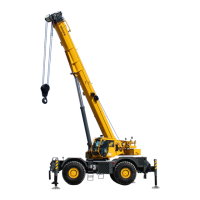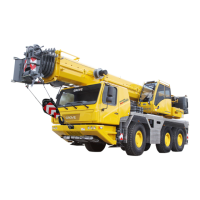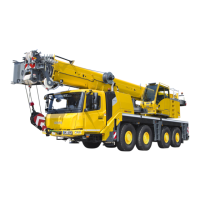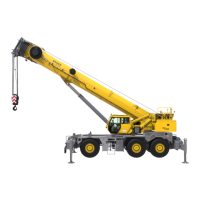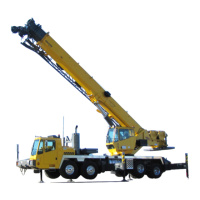OPERATING CONTROLS AND PROCEDURES CD5520/YB5520 OPERATOR MANUAL
3-18 Published 07-06-2017, Control # 406-03
NOTE: Check the instrument panel gauges frequently
during operation. Any abnormal readings should be
investigated and corrected as soon as possible.
Changing Travel Direction
1. It is recommended that the crane come to a complete
stop before changing travel direction.
NOTE: The transmission electronic control unit (ECU)
contains a setting that will prevent a change in
direction from taking place (to protect the
transmission from abuse) when the traveling speed
is too high. A repeated double beep will sound until
the speed drops and change in direction is
accomplished, or the change is deselected.
2. Move the travel select lever to the opposite travel
direction.
Shifting Gears
NOTE: The transmission used on this crane is not an
automatic transmission. It is a “Persiflage”
transmission. The gears and clutches will not shift
automatically. Each gear range must be shifted
manually.
1. Up shifting to the next gear may be done at any engine
speed, while the crane is in motion, but first ease up on
the accelerator pedal.
NOTE: The transmission is equipped with a speed sensor.
This sensor protects certain shifting functions of the
transmission and is connected to a warning
beeper. Should a speed sensor signal not be
received by the transmission electronic control unit
(ECU) on power up, the ECU prevents the
selection of 4th gear. This is intended to indicate a
faulty sensor or wiring and all speed protection is
lost. If the signal is lost after power up, 4th gear will
be selectable until the power is turned off.
2. When downshifting, do not over-rev the engine. Allow
the crane to slow down before shifting to the next lower
gear. Downshifting is subject to speed limitations. If the
speed is too high a repeated double beep is sounded
and will continue until the speed drops below the limit or
downshift is deselected.
3. The Kickdown Switch, on the end of the gear lever, can
be used to select the next lowest gear providing the
speed is not too high (a double beep will be heard if the
speed is too fast). Press the switch to select the next
lowest gear (except when in 1st gear). The transmission
will downshift for approximately 6 seconds and then
return to the higher gear. The kick down selection can be
cancelled by pressing the button again. It will also be
cancelled by reversal in direction.
4. It is recommended that the crane come to a complete
stop before shifting between forward and reverse.
The following practices could result in transmission failure:
• Shifting between forward and reverse while the engine is
at high speed or heavy throttle, such as when the driving
wheels are in mud or snow — commonly called rocking.
• Shifting to reverse or forward while operating the engine
at high speed in neutral.
• Operating the transmission at or near “stall speed” for
more than 10 seconds at a time. “Stall condition” is when
the engine runs at high speed while the transmission is
in forward or reverse and the drive wheels are not
moving. For example, when the wheels are mired in
deep sand or mud, or when the crane is against a fixed
barrier.
• Downshifting at high speeds causing the engine to over
rev.
Stopping Travel
1. Apply the service brakes and downshift as necessary to
slow the crane until it comes to a complete stop.
2. Place the transmission select lever in Neutral (N) and
engage the parking brake.
3. Turn the ignition switch to the OFF position to stop the
engine.
4. If the crane is parked and unattended, remove the
ignition key.
Operating the Outrigger Controls
Proper Leveling of the Crane
ASME B30.5 specifies that if a crane is not level within 1% of
grade, the allowable capacities must be reduced. Therefore,
whether lifting on rubber or outriggers, it is essential that the
crane is level to within 1% of grade. The bubble level that is
provided on the crane is calibrated to be accurate within 1%
of grade.
To properly level the crane, the boom must be positioned
over the front of the crane, fully lowered to horizontal and
fully retracted (for cranes fitted with a boom rest, the boom
shall be stowed onto the rest). Raise and level the crane
using the outriggers; refer to To Extend and Lower the
Outriggers, page 3-19.
CAUTION
To avoid damage to the parking brake and crane, do not
apply the parking brake while traveling.
Disengage the parking brake before driving. Damage to
the crane can occur.
Reference Only

